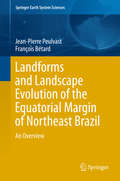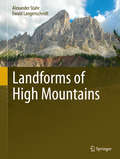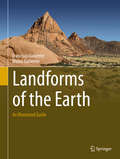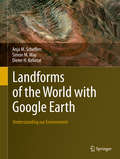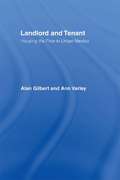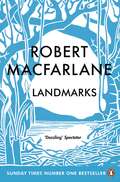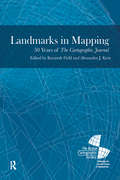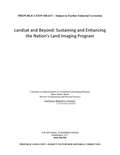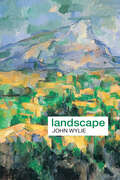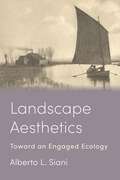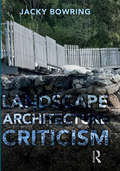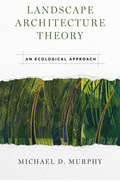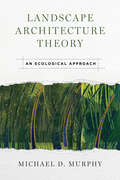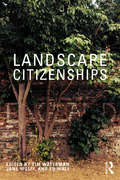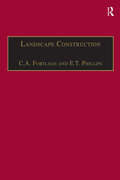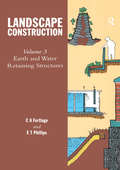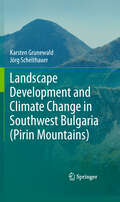- Table View
- List View
Landforms and Landscape Evolution of the Equatorial Margin of Northeast Brazil
by Jean-Pierre Peulvast François BétardMore than a simple monograph, the authors present a comprehensive geomorphic overview of a large tropical region where they show how deciphering the long-term landform evolution helps understanding the present set of landscapes and morphodynamic environments. The Equatorial margin of the Brazilian "Nordeste" displays stratigraphic landmarks whose interpretation reveals the age and nature of landforms, leading to a reconstruction of the geomorphic history by the means of combined morphostratigraphic and morphopedological approaches. Beyond the role of differential erosion related to moderate post-oceanic opening uplift, the plain and upland landscape reflects a juxtaposition of landform and soil generations related to a shallow basin inversion, the last stages of which occurred in semi-arid conditions since the Oligocene. These results throw light on old debates on models of long-term landform development in platform areas, and also help evaluating recent models of denudation and burial based on thermochronological methods.
Landforms of High Mountains
by Alexander Stahr Ewald LangenscheidtThis image atlas and reference book is written in simple language that can be understood by a broad audience. The work comprehensively explains the geomorphological forms of high mountains using many examples like glacial erosion forms and deposits such as moraines and gravel terraces, which are illustrated with numerous photographs. Landslide landscapes, volcanoes, weathering, and erosion are other examples discussed. These examples are from across the world, including the Himalayas, the Alps, the Andes, and the Southern Alps of New Zealand. This work is useful for laymen who are interested in geosciences, especially high-mountain landforms, as well as for students and teachers of earth sciences.
Landforms of the Earth
by Francisco Gutiérrez Mateo GutiérrezThis is a highly illustrated book with each landform being described with the following structure: (1) Main characteristics, including geometric, morphometric and sedimentological features. (2) Genetic processes and controlling factors. (3) Different typologies if applicable. (4) Additional comments related to various relevant aspects such us environmental implications or geographical distribution. Image visualization of landforms is essential for learning geomorphology and stimulating the interest in this field-based subject; a picture is worth a thousand words. Consequently, the book constitutes a valuable educational resource for every university student enrolled in courses related with earth surface processes and landforms (e. g. Geomorphology, Physical Geography, Geology, Geohazards, Environmental Sciences. ). The book is also attractive to travellers and people keen on nature who want to know about the terminology and origin of the landforms they encounter in their trips. In many cases, the geomorphological features constitute the main asset of first-class protected areas (e. g. , UNESCO World Heritage Sites, National Parks).
Landforms of the World with Google Earth
by Anja M. Scheffers Dieter H. Kelletat Simon M. MayThis book of phenomenal illustrations provides a wealth of visual information on the wide variety of landform processes over all latitudes, climates and geological time-scales. It invites you to observe the surface of planet Earth, to appreciate its astonishing beauty and to explore scientific explanations for the form of our landscapes. 250 full-colour images from Google Earth enable all types of terrestrial environments and landforms to be appreciated at a glance. Images are explained with scales, coordinates, explanatory text and references, making the landform processes active on our globe easy for the reader to comprehend. See the effects of both sudden and slow forming agents such as the impact of a comet or meteorite, and erosion and deposition processes through wind, flowing water, creeping glacier ice, or frost in the ground. Appreciate how landscapes are shaped by processes such as weathering, transport and erosion and how that erosion enables us to look into endogenic processes (those within the Earth´s crust), called tectonics. These images and the processes that they document show that continents are shifting, mountains are uplifting, and ocean bottoms may sink deeper. This collection will appeal to everyone: researchers, students and non-experts alike can take inspiration from these images, which bring the landforms of the world to life. The scientific discipline of geomorphology becomes accessible through the fascinating insights that these clear, well explained images allow.
Landing the Paris Climate Agreement: How It Happened, Why It Matters, and What Comes Next
by Todd SternFrom the U.S. lead negotiator on climate change, an inside account of the seven-year negotiation that culminated in the Paris Climate Agreement in 2015—and where the international climate effort needs to go from here.The 2015 Paris Agreement on climate change was one of the most difficult and hopeful achievements of the twenty-first century: 195 nations finally agreed, after 20 years of trying, to establish an ambitious, operational regime to address one of the greatest civilizational challenges of our time. In Landing the Paris Climate Agreement, Todd Stern, the chief US negotiator on climate change, provides an engaging account from inside the rooms where it happened: the full, charged, seven-year story of how the Paris Agreement came to be, following an arc from Copenhagen, to Durban, to the secret U.S.-China climate deal in 2014, to Paris itself. With a storyteller’s gift for character, suspense, and detail, Stern crafts a high-stakes narrative that illuminates the strategy, policy, politics, and diplomacy that made Paris possible. Introducing readers to a vivid cast of characters, including Xie Zenhua, Vice Minister of China’s National Development and Reform Commission, Bo Lidegaard, chief strategist for Denmark’s Prime Minster, and Indian minister Jairam Ramesh, Stern, who worked alongside President Barack Obama and Secretaries of State John Kerry and Hillary Clinton, depicts the pitfalls and challenges overcome, the shifting alliances, the last-minute maneuvering, and the ultimate historic success. The book concludes with a final chapter that describes key developments since 2015 and the author’s reflections on what needs to be done going forward to contain the climate threat.A unique peek behind the curtain of one of the most important international agreements of our time, Landing the Paris Climate Agreement is a vital and fascinating read for anyone who cares about the future of our one shared home.
Landlord and Tenant: Housing the Poor in Urban Mexico
by Alan Gilbert Ann VarleyThis ground-breaking work employs survey data and in-depth interviews to compile a detailed picture of landlords and tenants in developing countries. Focusing on Mexico the authors examine the state's housing policy, with its clear bias towards increasing home ownership, and explores the possibilities of improving the quality and increasing the stock of rented accommodation in the developing World.
Landmarks
by Robert MacfarlaneSHORTLISTED FOR THE SAMUEL JOHNSON PRIZESHORTLISTED FOR THE WAINWRIGHT PRIZEFrom the bestselling author of UNDERLAND, THE OLD WAYS and THE LOST WORDS'Few books give such a sense of enchantment; it is a book to give to many, and to return to repeatedly' Independent 'Enormously pleasurable, deeply moving. A bid to save our rich hoard of landscape language, and a blow struck for the power of a deep creative relationship to place' Financial Times'A book that ought to be read by policymakers, educators, armchair environmentalists and active conservationists the world over' Guardian 'Gorgeous, thoughtful and lyrical' Independent on Sunday'Feels as if [it] somehow grew out of the land itself. A delight' Sunday TimesDiscover Robert Macfarlane's joyous meditation on words, landscape and the relationship between the two.Words are grained into our landscapes, and landscapes are grained into our words. Landmarks is about the power of language to shape our sense of place. It is a field guide to the literature of nature, and a glossary containing thousands of remarkable words used in England, Scotland, Ireland and Wales to describe land, nature and weather.Travelling from Cumbria to the Cairngorms, and exploring the landscapes of Roger Deakin, J. A. Baker, Nan Shepherd and others, Robert Macfarlane shows that language, well used, is a keen way of knowing landscape, and a vital means of coming to love it.
Landmarks for Spatial Development: Equality or Differentiation (Contributions to Regional Science)
by Vikas Kumar André Torre Evgeny Kuzmin Yuliya Lavrikova Stanislav MartinatThe book explores the uneven spatial distribution of territory resources and its implication for the sustainable development of regions and cities. The authors analyze the features of the localization of assets, paying attention to both the manifested factors and the conditions that determine the specificity of the current spatial organization. On the basis of multivariate analysis, gravity models, clustering method, as well as the evaluation of concentration parameters, the authors propose various approaches to systematize territorial units, paying special attention to the peculiarities of their economic structure, resource diffusion barriers, and quality of life parameters. The obtained results indicate the need for a differentiated approach in the choice of guidelines for the transformation of the socio-economic space, allowing the researchers to propose various transformation models for differing regions. Thus, this book presents spatial organization models for different regional economies, highlighting various approaches to achieving the Sustainable Development Goals and reducing inequality. The book seeks to balance the benefits of polarized development with the need to avoid significant interregional disparities. At the same time, the book offers various solutions for differentiating territories, distinguishing different spatial elements, and determining the most appropriate transformation options. The results obtained may be of interest to scholars in regional and spatial science as well as to professionals in the field of territorial development management.
Landmarks for Sustainability: Events and Initiatives That Have Changed Our World
by Wayne VisserLandmarks for Sustainability is a high-impact, quick-reference guide to many of the most critical events and initiatives that have shaped our world, and the sustainable development agenda, over the past 20 years and more. These include high-profile historic events – such as the Exxon Valdez oil spill, the Rio Earth Summit, the anti-globalisation protests in Seattle and Genoa and the collapse of Enron – as well as more subtle but no less important developments, such as trends in fairtrade, ethical codes and sustainable investment. By shining a spotlight on these and other landmark events and initiatives, the book draws into sharp relief the most significant social and environmental challenges of our time – from climate change and the state of the planet to poverty and corruption. Equally importantly, however, more than half of the book is dedicated to constructive global responses, such as the boom in clean technology, the role of the World Economic and World Social Forums, and the growth of ISO 14001 and SA8000 standards. Each of the 20 chapters follows a similar easy-access full-colour design, with inspiring quotations, compelling photographs, a timeline of associated events, a narrative description of trends, and spotlight features of specific initiatives or events, including charts, factboxes and suggestions for further reading and websites. Also included is the world's most comprehensive sustainability timeline, listing and dating 190 key sustainability-related events and initiatives that occurred between 1919 and 2008. All these features combine to make the book an essential and highly accessible resource for managers, teachers, students, government officials, consultants and activists alike. For the first time, these crucial change agents will have a single-source reference book, which is not only packed with useful facts and figures, but is also fascinating to look at and full of inspirational material.
Landmarks in Mapping: 50 Years of the Cartographic Journal
by Alexander Kent"Founded by the British Cartographic Society (BCS) and first published in June 1964, The Cartographic Journal was the first general distribution English language journal in cartography. This volume of classic papers and accompanying invited reflections brings together some of the key papers to celebrate 50 years of publication. It is a celebration of The Cartographic Journal and of the work that scholars, cartographers and map-makers have published which have made it the foremost international journal of cartography. The intention here is to bring a flavor of the breadth of the journal in one volume spanning the history to date. As a reference work it highlights some of the very best work and, perhaps, allows readers to discover or re-discover a paper from the annals. As we constantly strive for new work and new insights we mustn't ignore the vast repository of material that has gone before. It is this that has shaped cartography as it exists today and as new research contributes to the discipline, which will continue to do so."
Landsat and Beyond
by National Research Council Space Studies Board Division on Engineering and Physical Sciences Committee on Implementation of a Sustained Land Imaging ProgramIn 1972 NASA launched the Earth Resources Technology Satellite (ETRS), now known as Landsat 1, and on February 11, 2013 launched Landsat 8. Currently the United States has collected 40 continuous years of satellite records of land remote sensing data from satellites similar to these. Even though this data is valuable to improving many different aspects of the country such as agriculture, homeland security, and disaster mitigation; the availability of this data for planning our nation\'s future is at risk. Thus, the Department of the Interior\'s (DOI\'s) U.S. Geological Survey (USGS) requested that the National Research Council\'s (NRC\'s) Committee on Implementation of a Sustained Land Imaging Program review the needs and opportunities necessary for the development of a national space-based operational land imaging capability. The committee was specifically tasked with several objectives including identifying stakeholders and their data needs and providing recommendations to facilitate the transition from NASA\'s research-based series of satellites to a sustained USGS land imaging program. Landsat and Beyond: Sustaining and Enhancing the Nation's Land Imaging Program is the result of the committee\'s investigation. This investigation included meetings with stakeholders such as the DOI, NASA, NOAA, and commercial data providers. The report includes the committee\'s recommendations, information about different aspects of the program, and a section dedicated to future opportunities.
Landscape (Key Ideas in Geography)
by John WylieLandscape is a stimulating introduction to and contemporary understanding of one of the most important concepts within human geography. A series of different influential readings of landscape are debated and explored, and, for the first time, distinctive traditions of landscape writing are brought together and examined as a whole, in a forward-looking critical review of work by cultural geographers and others within the last twenty to thirty years. This book clearly and concisely explores ‘landscape’ theories and writings, allowing students of geography, environmental studies and cultural studies to fully comprehend this vast and complex topic. To aid the student, vignettes are used to highlight key writers, papers and texts. Annotated further reading and student exercises are also included. For researchers and lecturers, Landscape presents a forward-looking synthesis of hitherto disparate fields of inquiry, one which offers a platform for future research and writing.
Landscape Aesthetics: Toward an Engaged Ecology
by Alberto L. SianiThe notion of landscape typically seems innocuous, associated with leisure and contemplation. Likewise, aesthetics is often seen as apolitical, a matter of subjective tastes and preferences. This book challenges the common understanding of these categories as disengaged and demonstrates how uniting landscape studies and philosophical aesthetics opens new ways of addressing both the environmental crisis and the crisis of the humanities.Alberto L. Siani argues that the concept of landscape helps us overcome deeply ingrained oppositions, such as nature and culture, spirit and flesh, or the environment and the human. Landscape represents the intersection of these categories and therefore provides a helpful vantage point on contemporary predicaments that cannot be understood within dualistic frameworks. An engaged aesthetics shows that landscapes are not simply ways of seeing the world but ways of being in the world, offering practical guidance for inhabiting places ethically. Landscape Aesthetics sheds new light on issues spanning art and its interpretation, environmentalism, temporality, lived spaces, justice, education, and interdisciplinarity. Bringing together a wide range of sources across philosophy and other disciplines as well as personal experience, Siani reveals the key role of landscape and aesthetics in responding to the pressing crises we face today.
Landscape Analysis and Planning
by M. Luc U. Somorowska J. B. SzmańdaThis book presents recent advances in landscape analysis and landscape planning based on selected studies conducted in different parts of Europe. Included are methodological problems and case studies presented and discussed during scientific sessions organized by the Commission of Landscape Analysis and Landscape Planning of the International Geographical Union (IGU) within the framework of the IGU Regional Conference in Kraków, Poland, August 18-22, 2014. The subject of landscape analysis and landscape planning has been of interest to geographers since the beginning of the twentieth century. This relatively new area of study, which focuses on the landscape resource patches and spatial interconnections, was first introduced as landscape ecology (Landschaftsoekologie) by Carl Troll, one of the twentieth century's most influential physical geographers. Today, landscape studies involve adopting a holistic view of geographic environments and are closely connected to rapidly developing ecosystem, sustainable landscape and ecosystem services approaches. Modern techniques employing Geographical Information Systems are used to support spatial landscape analyses.
Landscape Architecture Criticism
by Jacky BowringLandscape Architecture Criticism offers techniques, perspectives and theories which relate to landscape architecture, a field very different from the more well-known domains of art and architectural criticism. Throughout the book, Bowring delves into questions such as, how do we know if built or unbuilt works of landscape architecture are successful? What strategies are used to measure the success or failure, and by whom? Does design criticism only come in written form? It brings together diverse perspectives on criticism in landscape architecture, establishing a substantial point of reference for approaching design critique, exploring how criticism developed within the discipline. Beginning with an introductory overview to set the framework, the book then moves on to historical perspectives, the purpose of critique, theoretical positions ranging from aesthetics, to politics and experience, unbuilt projects, techniques, and communication. Written for professionals and academics, as well as for students and instructors in landscape architecture, it includes strategies, diagrams, matrices, and full colour illustrations to prompt discussion and provide a basis for exploring design critique.
Landscape Architecture Theory: An Ecological Approach
by Michael MurphyFor decades, landscape architecture was driven solely by artistic sensibilities. But in these times of global change, the opportunity to reshape the world comes with a responsibility to consider how it can be resilient, fostering health and vitality for humans and nature. Landscape Architecture Theory re-examines the fundamentals of the field, offering a new approach to landscape design.Drawing on his extensive career in teaching and practice, Michael Murphy begins with an examination of influences on landscape architecture: social context, contemporary values, and the practicalities of working as a professional landscape architect. He then delves into systems and procedural theory, while making connections to ecosystem factors, human factors, utility, aesthetics, and the design process. He concludes by showing how a strong theoretical understanding can be applied to practical, every-day decision making and design work to create more holistic, sustainable, and creative landscapes.Students will take away a foundational understanding of the underpinnings of landscape architecture theory, as well as how it can be applied to real-world designs; working professionals will find stimulating insights to infuse their projects with a greater sense of purpose.
Landscape Architecture Theory: An Ecological Approach
by Michael MurphyFor decades, landscape architecture was driven solely by artistic sensibilities. But in these times of global change, the opportunity to reshape the world comes with a responsibility to consider how it can be resilient, fostering health and vitality for humans and nature. Landscape Architecture Theory re-examines the fundamentals of the field, offering a new approach to landscape design.Drawing on his extensive career in teaching and practice, Michael Murphy begins with an examination of influences on landscape architecture: social context, contemporary values, and the practicalities of working as a professional landscape architect. He then delves into systems and procedural theory, while making connections to ecosystem factors, human factors, utility, aesthetics, and the design process. He concludes by showing how a strong theoretical understanding can be applied to practical, every-day decision making and design work to create more holistic, sustainable, and creative landscapes.Students will take away a foundational understanding of the underpinnings of landscape architecture theory, as well as how it can be applied to real-world designs; working professionals will find stimulating insights to infuse their projects with a greater sense of purpose.
Landscape Architecture in the Arab Middle East (Routledge Research in Landscape and Environmental Design)
by Jala Makhzoumi Beata DrekslerThis book explores the challenges facing landscape architecture in the Middle East. It supports the idea that landscape is a multifaceted idea, and examines landscapes architecture as an emerging profession in the region. The book also responds to the limitations of faulty translations of the English ‘landscape’ that, in turn, limit the professional potential in the region.The authors of the book see landscape as a way of beholding the world that is informed by place and culture. And because landscape is context specific, a landscape framing contextualizes a problem, be it community development, tourism, or nature conservation, to foster place and culture responsive perspectives. The nine chapters are grouped under four broad themes that reflect the multifaceted, ‘expansive’ framing that embraces landscape, natural and cultural heritage, people and livelihoods, and landscape and human rights.The authors recognize that a landscape framing is not the exclusive domain of landscape architecture, but can be applied by architects, planners, and environmentalists. The ideas advanced and issues discussed will be of interest to researchers, students, and practitioners in landscape architecture, architecture, planning, and urban design, as well as social and environmental scientists.
Landscape Citizenships: Ecological, Watershed and Bioregional Citizenships
by Tim WatermanLandscape Citizenships, featuring work by academics from North America, Europe, and the Middle East, extends the growing body of thought and research in landscape democracy and landscape justice. Landscape, as a milieu of situated everyday practice in which people make places and places make people in an inextricable relation, is proving a powerful concept for conceiving of politics and citizenships as lived, dialogic, and emplaced. Grounded in discourses of ecological, environmental, watershed, and bioregional citizenships, this edited collection evaluates belonging through the idea of landscape as landship which describes substantive, mutually constitutive relations between people and place. With a strong international focus across 14 chapters, it delves into key topics such as marginalization, indigeneity, globalization, politics, and the environment, before finishing with an epilogue written by Kenneth R. Olwig. This volume will appeal to scholars and activists working in citizenship studies, migration, landscape studies, landscape architecture, ecocriticism, and the many disciplines which converge around these topics, from design to geography, anthropology, politics, and much more.
Landscape Construction: Volume 1: Walls, Fences and Railings
by C. A. Fortlage E. T. PhillipsLandscape Construction Volume 1 deals with elements of landscape construction which are required to provide enclosure, privacy, demarcation of land, shelter and security. The elements discussed include free-standing brick and stone walls, fences, gates and railings. Fittings and finishes are also covered. Each section describes the materials, construction and constraints relevant to the subject and a large number of detailed figures and photographs supplement the text and help to illustrate the more important aspects. There is also a section on preservation treatment and painting. The current British Standard references are included.
Landscape Construction: Volume 2: Roads, Paving and Drainage
by E.T. Phillips C.A. FortlageLandscape Construction Volume 1 deals with elements of landscape construction which are required to provide enclosure, privacy, demarcation of land, shelter and security. The elements discussed include free-standing brick and stone walls, fences, gates and railings. Fittings and finishes are also covered. Each section describes the materials, construction and constraints relevant to the subject and a large number of detailed figures and photographs supplement the text and help to illustrate the more important aspects. There is also a section on preservation treatment and painting. The current British Standard references are included.
Landscape Construction: Volume 3: Earth and Water Retaining Structures
by E.T. PhillipsLandscape Construction Volume 1 deals with elements of landscape construction which are required to provide enclosure, privacy, demarcation of land, shelter and security. The elements discussed include free-standing brick and stone walls, fences, gates and railings. Fittings and finishes are also covered. Each section describes the materials, construction and constraints relevant to the subject and a large number of detailed figures and photographs supplement the text and help to illustrate the more important aspects. There is also a section on preservation treatment and painting. The current British Standard references are included.
Landscape Development and Climate Change in Southwest Bulgaria (Pirin Mountains)
by Karsten Grunewald Jörg ScheithauerLandscape Development and Climate Change in Southwest Bulgaria aims to address some of the current limitations in our understanding of past Balkan climate and environment. High mountains and their ecosystems offer an outstanding opportunity for studies on the impact of climate change. The Balkan Mountains in Southeast Europe, situated at the transition between temperate and Mediterranean climate, are considered as very sensitive to historical and current global changes. The geoarchives lake sediment, peat and soil, long living trees and glaciers have been used to reconstruct the climatically-driven change of forest and treeline during the Holocene and the younger past. These processes are interrelated with complex ecological changes, as for example the seasonality of climate parameters. The landscape research approach with the analyses through multi-palaeo-geoecological proxies is new for the Balkans.
Landscape Dynamics of Drylands across Greater Central Asia: People, Societies and Ecosystems (Landscape Series #17)
by Martin Kappas Garik Gutman Jiquan Chen Geoffrey M. HenebryThis volume is a compilation of studies on interactions of changes in land cover, land use and climate with people, societies and ecosystems in drylands of Greater Central Asia. It explores the effects of collapse of socialist governance and management systems on land use in various parts of Central Asia, including former Soviet Union republics, Mongolia and northern drylands of China. Often, regional land-atmosphere feedbacks may have large global importance. Remote sensing is a primary tool in studying vast dryland territories where in situ observations are sporadic. State-of-the-art methods of satellite remote sensing combined with GIS and models are used to tackle science questions and provide an outlook of current changes at land surface and potential scenarios for the future. In 10 chapters, contributing authors cover topics such as water resources, effects of institutional changes on urban centers and agriculture, landscape dynamics, and the primary drivers of environmental changes in dryland environment. Satellite observations that have accumulated during the last five decades provide a rich time series of the dynamic land surface, enabling systematic analysis of changes in land cover and land use from space. The book is a truly international effort by a team of scientists from the U.S., Europe and Central Asia. It is directed at the broad science community including graduate students, academics and other professionals at all levels within natural and social sciences. In particular, it will appeal to geographers, environmental and social scientists, economists, agricultural scientists, and remote sensing specialists.
Landscape Ecology And Geographical Information Systems
by Roy Haines-Young David R.Green Steven CousinsThe landscape we see and live in is an important part or our everyday lives, be they urban or rural. Environmental concern has grown in recent years, as a result of public awareness of the detrimental impact industry, transport and tourism can have on the ecosystem. This book examines the role of the new technologies of geographical information sys
